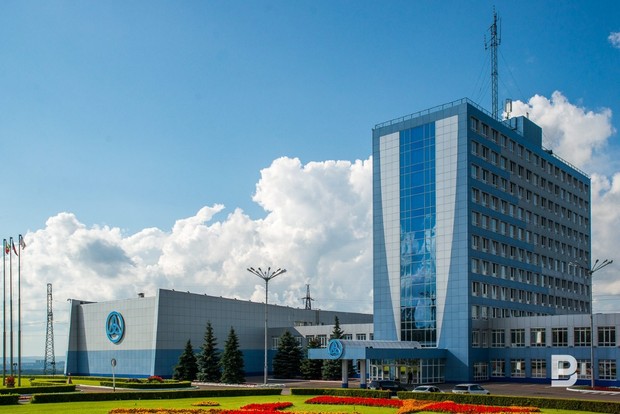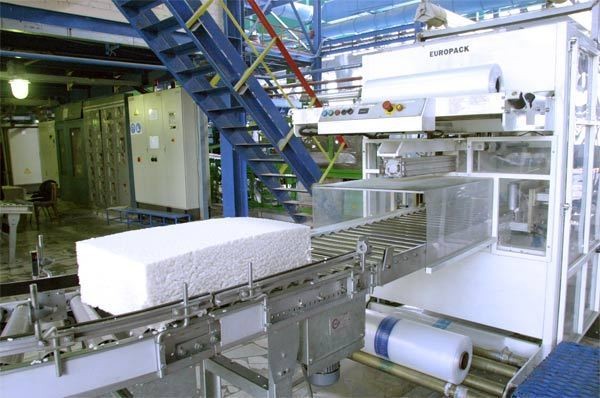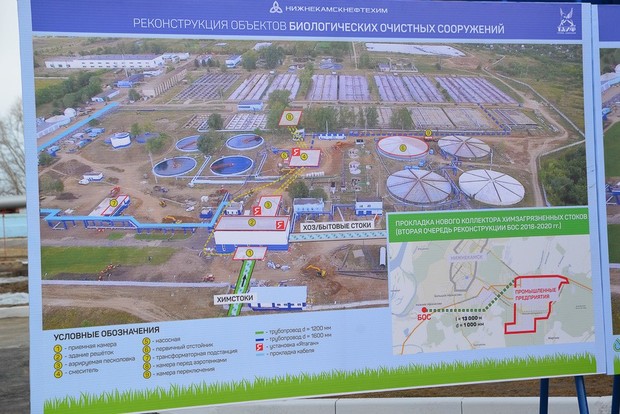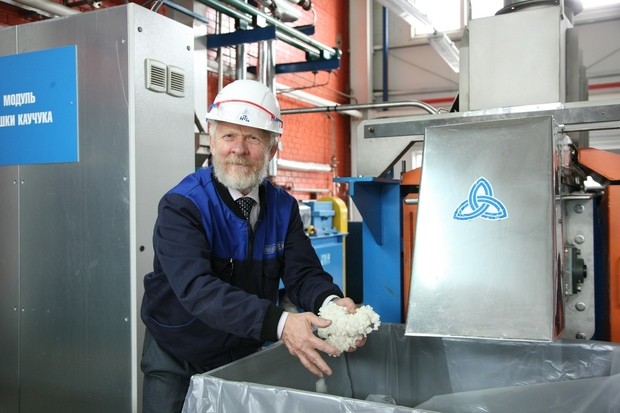Azat Bikmurzin: ''Deficit of ethylene is one of the key problems retarding the petrochemistry's development''
The head of Nizhnekamskneftekhim believes that the demand for synthetic rubber will grow
The project of the olefin complex, being developed by Nizhnekamskneftekhim and TAIF for many years, has received support of the government: it has been included in the development strategy of the petrochemical industry of Russia until 2030 since it promises to be ''the growth driver, which will initiate further chain of changes of petrochemical products and bringing it to the end-user.'' It was informed in the interview with Realnoe Vremya by Director General of Nizhnekamskneftehim Azat Bikmurzin. The head of the company also told about the current situation at the petrochemical giant of Tatarstan, what factors affected the decline in profits, as well as what challenges lie ahead for the current year, which is under the sign of the anniversary for the company. At the end of July it will turn 50 since Nizhnekamskneftekhim, at that time the petrochemical plant, received the first tonnes of products.
''The company's share in the total Russian production volume of synthetic rubbers is 52%''
As usual, in April at a meeting of shareholders of Nizhnekamskneftekhim they summarized the results for 2016 — the financial and production indicators are on the rise. Mr Bikmurzin, what results has the company achieved over the last four months of this year compared to the same period in 2016?
The expected performance in January-April of this year also allows us to speak about growth. Thus, the growth of commodity output in the comparable prices for 4 months of 2017, compared to the same period of the previous year, amounted to 4,9%. In physical volumes, we increased production volumes in the main range of commodity products, the sales revenues increased by 3,2%. The increased sales volumes played their role here.
However, the expected profit for January-April turned out to be below the profits obtained over the four month a year earlier. The reason for this situation, I must say, was the price factor, mainly, a lower currency exchange rate in the current year, and at the same time, increased prices for physical resources.
In the previous years, the growth driver of the company's revenue was synthetic rubber, then in the proportion of revenue they became almost even with plastics. What is the situation this year?
Indeed, if five years ago, in 2012, the share of rubber accounted for 48% of the total revenue, the share of plastics did for more than a quarter in 2016, the share of sales revenue of plastics amounted to more than 36%, and rubber – about 41%. However, this fact does not indicate a decline in sales of rubbers. The growth in sales volume of synthetic rubbers in the past year compared to 2012 in real terms was 13%, or nearly 76,000 tonnes. At the same time, sales volume of plastics in tonnage increased during this period by 16%, or by 97,000 tonnes.
Continuing on the topic. The branch Russian statistics says that in 2016 the volume of plastics production increased by 5% and of synthetic rubber — by almost as much (5,4%) compared to 2015. What is the situation in those segments of production in Nizhnekamskneftekhim?
Last year we reached the maximum production volumes of plastics — nearly 725,000 tonnes. Now our company has become the second largest plastics manufacturer in Russia. Further increase in volume of their production will be possible only after increasing production capacities. Nevertheless, we try to optimize the production structure so as to meet the needs of the market, to withdraw from those sectors where competition is the most acute, and to increase our presence where the domestic product is not enough. In other words, now Nizhnekamskneftekhim works not on volume but on quality of sales. For example, over the past four years we were increasing production of more high-tech copolymers of propylene by reducing the production of homopolymers. Thus, in the structure of production the share of copolymers increased to nearly 90% in 2016, from 54% in 2013. Due to this, the company managed to increase its share on the Russian market of propylene copolymers by 9%. By the way, this volume was successfully reconquered from foreign suppliers.
The same can be said about linear low-density polyethylene (LLDPE). If in 2013 we sold 26,500 tonnes of LLDPE, in 2016 — 64,600 tonnes, just in 3 months of the current year — over 30,000 tonnes.
At the same time, Nizhnekamskneftekhim is the only domestic manufacturer able to produce LLDPE. Our goal for this year is to produce and sell not less than 100,000 tonnes of polyethylene, and in the long term — to reach annual volume of 150,000 tonnes.
Besides, in the framework of import substitution, the company is developing the production of grades of medium-density polyethylene for the production of products using rotational molding method. As a rule, it is tanks up to 10 cubic metres. Over two years, the plastics plant mastered industrial production of the special grade of polyethylene, which is used as an external anti-corrosion coatings for steel pipes. Positive conclusions from Transneft have been obtained, and it makes possible the use of Nizhnekamsk polyethylene in large-scale government projects, involving the laying of pipelines.
Speaking of rubbers, Nizhnekamskneftehim is the largest domestic producer of synthetic rubber — the company's share in the total Russian production is 52%, by production volumes we are the seventh in the global ranking of producers of synthetic rubbers. In 2016, the company produced 671,000 tonnes, which is by 3,7% more than a year earlier.

At the same time, we continue to invest in production of elastomers and we are planning to increase the volume of their output, their range. So, this year we will increase the production of butyl rubbers and the production of isoprene rubber by 50,000 tonnes. Besides, we have plans to organise in the next two to three years an industrial production of styrene-butadiene rubber (SBR) in the amount of 50,000 tonnes a year, and in the future it will be increased to 100,000 tonnes. Therefore, in the medium term, Nizhnekamskneftekhim's volumes of rubber production will definitely grow.
It is known that Nizhnekamskneftekhim plans to increase the volume of rubber production up to 1 million tonnes a year. Today, the company produces 670,000 tonnes of rubber, sales of which is guaranteed by long-term contracts with five global tire corporations. On what is the belief that in a few years millionth volume will be in demand by manufacturers of tires and rubber-industrial goods based?
The strategy in the synthetic rubber segment is closely linked with the development plans of our major customers and market trends. In fairness I must note that we do not rely solely on the ''big five'', although, of course, we see it as concentration of main volumes. But we have large customers in Tatarstan, as well as in Russia, the near and far abroad. We also rely on them and we will be ready to provide their needs in raw material volumes and range.

Since we are talking about the range, today our company is entering a new stage of development. We see changes in the tire market. More and more preference in the world is being given to tires with high performance characteristics. This requires from the tire companies a continuous work on formulations of rubber compounds with the aim of improving the hysteresis properties of tires, reducing rolling resistance, improving adhesion to wet road surface, and from suppliers of rubbers — improved elastomers. So today we are actively working to expand the range of synthetic rubbers, with the inclusion of special types of elastomers that will be able to provide the necessary performance in rubbers, as well as on further improvement of the quality of rubbers. We are confident in success that gives us reason to believe that our synthetic rubbers will be needed in the future.
Mr Bikmurzin, today the market is unpredictable: now the oil price falls, then the ruble falls, or something else might happen. Have you armed with some measures in order to survive in such conditions?
According to our observations, the general trend is that every year the market becomes more and more volatile. Of course, it applies in different degrees to different types of products. But the trend is still the same, and it comes from three main premises: overproduction and, consequently, volatility in the energy market (oil); a wave of new production capacities, which is accompanied by increased competition, and the third factor is the rate of Russian ruble.
At the same time, neither we nor other market players can influence these factors. Even in these circumstances, we try to strengthen ties with domestic and foreign refiners, to follow the market trends — new brand of products is being developed, and we are working on improving the quality of existing ones. I want to point out that the special attention is given to the quality of products.
We also try to promote our products and new developments in the market, for which we carry out scientific and technical forums. By the way, in September we plan to hold another polymer forum in Kazan, where we plan to gather domestic and foreign processors of plastics and synthetic rubbers.
In general, I would emphasize that Nizhnekamskneftekhim is the company that has its feet on the ground and confidently survived several crises. Wide diversification of product chains and vertical integration allow us to successfully operate in the market. Besides, the synergy in the group of companies TAIF also help, in the framework of which the delivery of raw materials and products is arranged.
As for sales of plastics, mostly they are purchased by large processors, meanwhile, the regional processors have repeatedly complained to President Rustam Minnikhanov to the fact that they can not buy polyethylene or polypropylene from Nizhnekamskneftekhim because of too high prices. How is the problem of working with small and medium business of the Republic being solved today?
As for sales of plastics to big processors only, it is not exactly. We sell plastics to different categories of purchasers and those who buy from 4-5 tonnes and those who need 5-10,000 tonnes a month. We try to meet needs for products of all the purchasers depending on production possibilities. In addition, we monthly place our products on Online Contract e-commercial platform. It makes it more available to a wider circle of purchasers.
Speaking about regional processors and small and medium business entities, Tatneftekhiminvest-holding annually creates a delivery plan of products to Tatarstan enterprises by assortment and volume approved by the president of the Republic of Tatarstan. For us, it is a plan of work, and we strictly follow it.
Another thing is when some small business entities speak about a desire to get products on privileged terms explaining it by the status of the small enterprise. But we can't do it. Our company sells its products depending on market conditions and competition because the geography of sales doesn't limit to Tatarstan only. The company sells plastics to both regional and Russian and foreign processors. At the same time, we are ready to support solvent regional processors but we are not ready to breach market pricing principles and anti-monopoly legislation. And granting privileges to regional enterprises like lower prices can create discriminatory conditions in the market where several business entities will be in an equal situation in comparison with other business entities, which is forbidden by provisions of the federal law ''On Protection of Competition''.
2017 goals: olefin complex, environmental protection and design of new product types
Tatarstan has recently had its own law on industrial policy. The document has the order of application of already existing measures to support enterprises and enumerates new ways of support that will particularly affect the project of Nizhnekamskneftekhim's olefin complex. Did the company get the long-awaited support of the republic?
The law on industrial policy introduced such a new state support tool as Special Investment Contract (SpIC). The state guarantees an enterprise that signed a SpIC that benefits and privileges won't change during the whole term of the contract even despite changes in the law if they happen. However, here we are talking about support measures that existed when the SpIC was signed that were defined by corresponding legal acts. Despite a variety of state support measures, their majority is designed for small and medium businesses of some industrial sectors. Unfortunately, these measures are restrictive for such a large-scale petrochemical project as the new olefin complex. However, there is certain progress here.
For instance, last year, there were made amendments to the Tax Code of the Russian Federation that allow industrial enterprises including Nizhnekamskneftekhim as participants of special investment contracts to get relief on income tax in the part that is send to the federal budget. In this case, the enterprise doesn't pay the current 2% tax during the term of the contract. In addition, very regions are given the right to reduce the income tax rate in the regional part. I think it is quite a perceptible support measure allowing to send the money saved as a result of tax breaks to, for instance, pay off investment loans taken during the realisation of the project.
I will note that nowadays the Ministry of Finance of the republic is already considering our offer to apply concessionary income and property tax rates within the special investment contract.
What about the project of EP-1200 and its inclusion in the federal Strategy-2030?
The last version of the federal development strategy of chemical and petrochemical complex until 2030 was approved in January last year. It is said that a deficit of monomers particularly ethylene is one of the key problems retarding the petrochemistry's development, and its further development is impossible without an intensive creation of pyrolysis capacities.
This is why our project is not only on the list of projects designed to be accomplished within the Strategy but also the main growth driver that will found chains of petrochemical conversions and deliver them to the final consumer.
By the way, Nizhnekamskneftekhim representatives directly participated in the creation of the Strategy in the working group, and our projects were included there at the design stage.
It is no secret that many operational capacities of Nizhnekamskneftekhim became obsolete. And the company has been updating them for 10 years. However, does the Federal Environmental, Industrial and Nuclear Supervision Service have more requirements to provide industrial safety in facilities of the enterprise? What was done in this area (to eradicate defects)? What are you going to improve in this segment?
As far as you know, the first product of the central NGL fractionation plant (CGFP-1) was made 50 years ago. The enterprise has been developing dynamically since then by annually increasing production volumes and mastering new segments of the Russian and world economy. Over the last 10 years, Nizhnekamskneftekhim has built and launched the production of new polystyrene, polypropylene, polyethylene, ABS plastics, updated production of linear alpha olefins. And a big job on modernisation of operating factories is also carried out.
In addition, we don't forget that about 63% of the equipment have being used for more than 20 years since they were put into operation. This equipment's industrial safety is annually checked to define the remaining resource and solve the problem on a possibility of its further use. I want to emphasise now that we don't use the equipment that is not approved by the expertise. At the same time, works on major overhaul of the equipment take place every year during which the safety margin and its resource increased. Physically worn out equipment is simultaneously substituted: for instance, last year, we substituted almost 210 units.
What is more, over the last years, the company has designed and implemented electronic software that allows to supervise processes of technological and energy equipment's work online. Realisation of such products enables our specialists to analyse the state of the equipment in detail, plan a timely diagnosis and repair, which, in turn, reduces the risk of appearance of emergency situations linked with an early collapse of the equipment.
As for implementation of modern requirements and latest technologies in industrial safety, the enterprise has taken over 5,000 measures of this kind in the last five years, and the work in this area is performed constantly.
Ecology is a priority for everyone, especially for petrochemical companies. It is known that the fourth eco-programme until 2020 with a budget of over 7bn rubles was adopted at Nizhnekamskneftekhim and is under way. The first stage of reconstruction and modernisation of the Biological Treatment Plant already finished. What plans do you have for this year after President Rustam Minnikhanov expressed his hope that ''the second stage will be performed on time'' during his recent visit to the company?
Further reconstruction of biological treatment facilities is very important because we are going to reconstruct the part where wastewater is treated at the second stage. Here we need to very carefully evaluate all the risks of possible treatment problems of this wastewater. First of all, we need to consider the inhomogeneity and specifics of the wastewater coming for treatment from all the enterprises of the Nizhnekamsk Industrial Hub. This is why the second stage of reconstruction will be preceded by a scrupulous and careful work on doing laboratory analyses and pilot tests of offered technologies to choose the most effective one to treat the wastewater, collect and neutralise gas exhausts in the end.

Nowadays the companies we are going to do this research with are known, and technologies were created. The design and working documentation will be prepared for the chosen technologies and equipment will be ordered.
Mr Bikmurzin, why does the reconstruction of the Biological Treatment Plant have two stages?
Biological treatment plants are the only facility in the city where both industrial and urban wastewater is treated, which means a work in a non-stop regime. This is why it is necessary to reconstruct without stopping the treatment process. What is more, the treatment plants are among the biggest facilities. This is why costs on their reconstruction are not small. Considering these factors, it was decided to reconstruct the Biological Treatment Plant gradually.
What does the eco-programme include besides the reconstruction of wastewater treatment facilities? Do you pay attention to the fact that in social networks and at meetings with officials of the city citizens complain about unpleasant smells coming to the city from the industrial zone especially at weekends accusing Nizhnekamskneftekhim of it?
Apart from the reconstruction of the Biological Treatment Plant, our programme presupposes and tales measures that will help to save water resources, reduce the amount of wastewater by improvement of circulating water supply system, treatment and return of wastewater to the production cycle. To improve the quality of the wastewater, a big job on treatment of buffer ponds on the River Tunguch is done.
Much is done to reduce emissions, eliminate smells and rationally use the feedstock: technological equipment is renewed and updated in factories of the company, removals are accumulated in one place and then transferred to the flare system. Very flare vents are then used as fuel. Implementation regimes of technological processes are optimised in factories. Gas treatment facilities are installed in wells located in the first and second industrial zones – bio-filters that allow to neutralise smells. In addition, lands are cultivated again, not only territories of the enterprise but also residential districts of the city are improved and greened within the programme.
As for the complaints about unpleasant smells, I should note now that the Nizhnekamsk Industrial Hub includes over 75 industrial enterprises, the urban infrastructure constantly develops. At the same time, we pay attention to every complaint. Examination of every complaint is immediately done with visiting the site, samples are taken and their analyses are done by an accredited laboratory. In the recent time, we started to examine the territories where complaints come from together with specialists of supervisory bodies. We think it will enable to increase the efficiency of measures to detect the source of emissions of contaminating substances.
What is more, Nizhnekamskneftekhim has automated air monitoring on both the perimeter of the industrial site and in treatment facilities whose data is analysed by environmental protection workers and dispatchers online.
Back to the major, production of Nizhnekamskneftekhim. What breakthroughs were made in the enterprise last year? What plans do you have for this year?
I would like to divide the technologies mastered by Nizhnekamskneftekhim last year into licensed and its own, which were created by our Scientific and Technological Centre (STC). α-SABLIN production of alpha olefins by Linde is the first one. This technology allows to regulate the balance of light and heavy olefins within certain limits. It enabled us to produce light olefins – butane, hexane, which are successfully used in the factory manufacturing plastics.
Speaking about our own developments, our scientists in STC created several technologies that were successfully approved in production. Particularly, production technology of functionalised styrene-butadiene rubber by batch method was created during the last year. At the same time, a test batch unit was created in Synthetic Rubber Plant based on BR-L industrial site. And covering the beginning of 2017 already, we can speak about production tests of new SBR-621.

Samples of products were carefully examined. Results of the research show that the created technology enables to make functionalised styrene-butadiene rubber with characteristics close to the best import analogues and even better in some indicators. We sent samples of the new diene-styrene synthetic rubber for a test to leading Russian and foreign tyre companies like Nizhnekamskshina, Cordiant, Continental, Pirelli and Bridgestone. We are waiting for opinions.
I already said about polyethylene for isolation of gas and oil pipes. It is also a development of BR like the production technology of new black bimodal polyethylene to make jacket for high-voltage cables.
This year the work on creation and implementation of new technologies continues, of course, first of all, on extension of types of polypropylene to make car components, create and implement the production technology of neodymium polybutadiene for ''green'' tyres and monomer production.